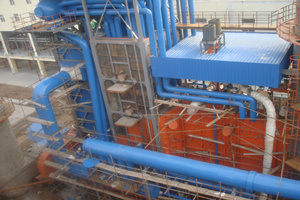1) Technical scheme of hot flue gas oven
At present, there are many types of fuels used in ovens, such as oil, natural gas, blast furnace gas, methanol and so on. The fuel of the oven is connected through the boiler pipeline system. At the same time, a fan is provided for each oven, so that the hot flue gas can be evenly sent to each part of the boiler. One oven is arranged on the left and right sides of the ignition air duct, and the hot flue gas can enter the furnace through the ignition air duct. Two ovens are arranged in the start-up burner under the bed, and the hot flue gas can be transferred to the fuel through the air cap hole under the bed. One oven is arranged on the left and right sides of the furnace, and the hot flue gas enters the furnace directly. One oven is arranged on the left and right sides of the return valve, and the hot flue gas can enter the separator through the return valve inlet door. Two ovens are arranged in the inlet flue of the separator, and the hot flue gas can enter the mixing chamber through the orifice door. Generally speaking, the circulation of hot flue gas in the boiler is mainly divided into two types, one is through the under-bed burner and the ignition air duct into the furnace to the separator outlet flue, the other is through the return valve, separation The device enters the exit flue.
2) Application advantages of hot flue gas oven technology
(1) Because the oven uses a multi-point layout, this can optimize the application time of the oven, and then realize the optimal distribution of energy, which can improve the effective utilization of hot flue gas heat. At the same time, 8-12 ovens are arranged outside the boiler, which can meet the different needs of boilers at different locations and avoid waste of heat resources.
(2) It is convenient to control the temperature of the boiler section. The hot flue gas oven technology aims to control the temperature in the boiler by controlling the outlet temperature of the oven outside the furnace, and at the same time adjust the pressure and air volume of the oven and other related parameters, so as to ensure that the temperature curve of the boiler is in accordance with the design standard conduct. At the same time, it can effectively avoid the sudden increase or decrease of the temperature, so that the stability of the boiler material can be further ensured, and the application performance and application period of the boiler can also be effectively ensured.
3) Matters needing attention in the application of hot flue gas oven technology
(1) Prevent excessive temperature deviation;
(2) It is necessary to ensure the reliability of the power supply of the oven, and the power supply cannot be stopped during the oven;
(3) The problem of water shortage or full water should not occur during the drying process;
(4) Control the air volume in the initial stage of the oven to avoid excessive heating of the boiler;
(5) The opening of the dehumidification hole must be done before the drying furnace to ensure that the moisture in the castable can be discharged in time;
- Conclusion
The most significant difference between CFB boilers and conventional boilers is that the castables used in CFB boilers are wear-resistant refractory materials, and the stability of the castables is also an important guarantee for the long-term stable operation of CFB boilers. For this reason, in order to ensure the application performance of CFB boilers, it is necessary to do a good job in the selection of wear-resistant refractory materials, construction, and oven operations.



